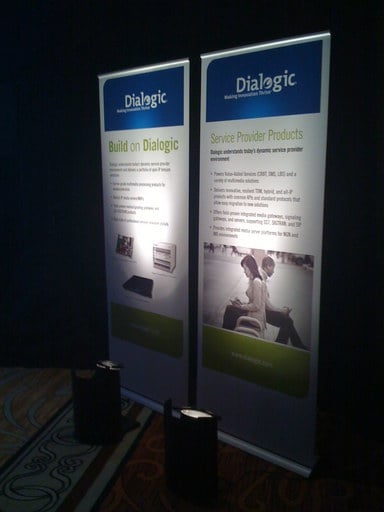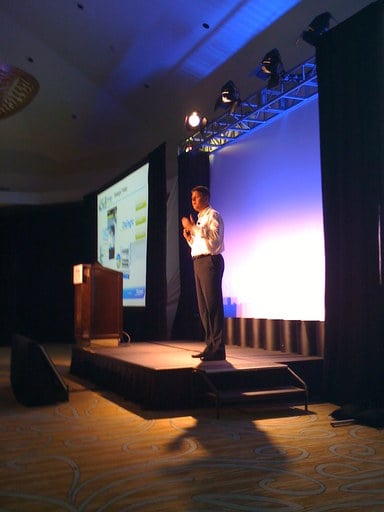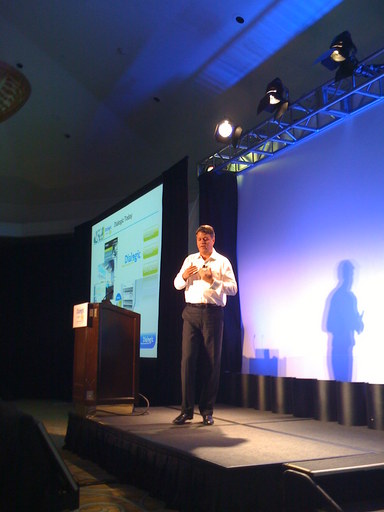Jensen was right at home on the stage and as always, was full of passion and enthusiasm. He started the session with a recent history of his company including the acquisition of the Dialogic brand from Intel by Eicon Networks, the purchase of Cantata which was once three companies, Brooktrout, Excel and Snowshore Networks. This led him to discuss the recent acquisition of NMS which is still pending.
He explained the company will do about $220 million in sales this year and this was a bit slower than expected. Jensen alluded to the fact that if you weren’t a CNBC watcher a few months ago, you are now. He mentioned the credit markets and global stock market crashes. He went on to say, a week ago things were worse but the markets are now behaving better. Jensen explained the credit markets are the most important factor in our markets today. He explained that without credit, you can’t sell your products (likely referring to financing mechanisms). He went on to discuss how in an industry awash in acronym s we have had to learn new ones like CDO and LIBOR.
The question he asked, is when will government intervention produce results? To this question, Jensen answered with words of advice. He explained we should watch our costs but keep our long-term vision. He said, now is a good time to reevaluate business models and think about things like adding video to your solutions. Jensen says video is the future for his company and as an industry we need to focus on it.
He went on to explain the company is in the business of providing enabling building blocks which you can use to sell a solution to an enterprise or carrier. He explained that the company will not produce applications which compete with customers.
He then segued into how he has talked about consolidating the industry. He says as an infrastructure provider, size and scale matter. He went on to say “mission accomplished.” The next step is video, security, deep packet inspection and more. He says video will hit 3G handsets before the enterprise deploys it en masse.
He mentioned one application which is needed is keeping adult content off your kid’s 3G handset. He also discussed how as they progress in this space, they may acquire and/or build products organically.
He says when you produce video applications, you need to create demand. “Most people don’t know why they need video,” he exclaimed. He went on to discuss how caller ring back tones are an example of an application which we could not foresee. “Teenagers are now driving this six billion dollar market today,” Nick explained.
He then mentioned a video caller ring back tones. Do we want to see this? He says most people will not, but family members just might. He repeated emphatically to “think outside the box.” He says, if you stay in your box, someone else who is young and innovative will take this opportunity away from you. He says they will likely come from another country which is ahead in the video space. He said, “If you are in the voice or fax business, I urge you to consider video as it will be crucial at some point soon.”
Where are the biggest markets for video today? He says CALA, India and China. Video to the enterprise is not happening on a mass scale yet he explained. The reasons may have to do with screen sizes or UC integration. He said enterprise customers generally take a few years to adopt new technologies.
Jensen explained his company plays in the edge network space – where customers buy the media and signaling components from Dialogic. He says that the edge will grow and call centers will soon upgrade as well to add video capability.
Jensen said emphatically, “Video is the new voice and a will be a huge platform going forward.”
He then went on to detail a sample solution where a person on a 3G Blackberry could be on a call with and could say “compliance” and some code words relating to where the conference is to be stored. For example, project “take over”, involving company “X and Y.” He says this ability to record and file a conversation will enable you to instantaneously call up the results of the conference call with full recordings and screen shares as needed.
He says in the economic crises of the day, this sort of technology could have been crucial. He says, in court you would need to be able to prove such files have not been altered. He mentioned that Dialogic technology can allow this functionality today and companies looking for compliance solutions will be interested in purchasing it.
Jensen then went on to say video is incremental – it does not replace voice or fax or cannibalize it.
He then discussed more applications based upon the meetings he has had with global carriers. He suggested that developers too speak with customers before they develop code to ensure they are on the right track.
Jensen went on to explain how a 3G video-enabled phone could be used to video record a problem and send it to a ca
ll center. At this point a video call can be initiated and the customer can have their problem solved in real time – while looking a call center agent in the virtual “eye.” He envisions global mass contact center upgrades as the movement to video proceeds.
He then explained how 3G gaming allows multiplayer functionality and the future is HD gaming and video. He says you will now be able to look someone in a gaming room in the eye on an iPhone or Blackberry Bold. He alluded to strategy games such as poker where seeing the opponents face makes the experience better for all involved.
He says today’s social networking generation is familiar with video and therein lies the opportunity.
In the future, Jensen sees P2P video conferencing/collaboration being a huge opportunity. Virtual tours of hotels (I would add real estate to this example) are a great example. He also thinks social and dating applications are a natural and he reiterated people may not know they need it but once they try it and see it is easy, they want it.
Another application Jensen explained is soon to appear in India where you will be able to call a yellow pages type of service where you can say “Starbucks” and the application will come back with a map of where you are and where you want to go. In addition, if you allow it, you will get a video and coupon. In this example, the carrier gets revenue from the customer, the directory company and the coffee shop. He explains that video is the only thing that will help ARPU go up in India. Analysts predict that ARPU will go from $8 to $9.50 in this country, which is not a huge dollar volume but adds up when you have a billion users.
Another important point Jensen made and I agree with is the first mover advantage is huge in business. You want to be first with successful applications, not second, third, etc.
The great examples continued to flow as Jensen described being able to speak into an automated assistant and tell it you are two adults and three kids and over the weekend in New York you want to go to a museum, Broadway show and a ball game and you like French and Italian food. The application could come back with a detailed schedule and a mashup of maps showing you how to get to your destinations. For example, you could be told to visit the museum at 10:00 AM, then the Ball game at noon. Lunch is hot dogs in the stadium, followed by an early dinner at a nearby Italian restaurant near Broadway.
Jensen explained that many applications can be upgraded to video with little effort. He says they are betting a great deal on video and are really serious about this market. He thinks in less than a year the company will be a major player in the space.
Next up was Joe Mele, the head of the Dialogic Media Labs. Early into his presentation he began discussing how H.264 is becoming a compelling and global standard for video compression. You get 2x the performance with the same bandwidth as previous technology he explained. He related this standard to the MP3 standard which became the audio standard.
The company is busy building products and filing for patents in the space. They are coming out fully featured. He explained his team has done similar things before and just like building multiple houses, each time you build one, you come up with better ideas on how to do things.
Applications discussed and profiles built-into the Dialogic platforms include mobile video streaming, desktop video conferencing and IPTV. These will all be in the box when customers want to build solutions for these markets he explained. Beginning the second half of next year, we will begin to see these codecs in the media server and gateway product families.
From there the audience witnessed mobile video demonstrations based on Dialogic technology and the competition. As you might expect, Dialogic generally beat the competition in all the demos we saw. The company’s solutions seem to really excel when conditions are less than perfect.
Although we are only a few hours into this event I get the feeling the video market is hitting critical mass. With standards in place, powerful devices with bigger screens and 3G and 4G networks springing up around the globe, there is no reason to think there won’t be a slew of new multibillion dollar applications we can’t even conceive of yet. If you look at the SMS market, you realize billions are being spent on just one simple application so it may just be one killer video app that changes the world. We may not need dozens. I can see video and collaboration compliance alone topping $10 billion annually at some point in the next 5-10 years. The applications Jensen and Mele discussed today are compelling and I would at least try them all myself. Admittedly I am not the demographic for 3G video but still, I have been surprised at how much video content I have been consuming as of late because I have an iPhone with me at all times.
If Jensen is right and (mobile) video is the new voice, then we will see the IP communications market enjoy massive resurgence once again. After all, the market for conferencing, video and collaboration is already exploding with growth. When you add in mobility the potential seems to grow exponentially.










